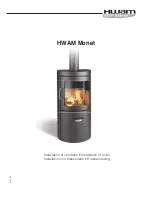
Atmos
Heating Systems
Installation and user manual EN_FMT
25
CHAPTER 7. MAINTENANCE
High voltage! ! !
The wiring of the pump, the three-way valve, fan and
wiring of the gas block can be under a voltage of 230
VAC.
Serial connection
A PC or Laptop can be connected for an extensive diagnosis
and display of the functionality.
The necessary cable (which contains an electrical isolation)
and software can be ordered as options.
7.1. ANNUAL MAINTENANCE
After the first year, have a recognised installer or maintenance
man inspect the unit. He can ascertain the maintenance
deadline on the basis of the inspection and circumstances. A
certified (SCIOS) installer should inspect the unit annually.
7.1.1. Checking the CO
2
percentage on full load
The nominal value for natural
gas at full load is 8.8% CO2.
The unit does not need to be
cleaned if the measured CO
2
percentage at full load is within
8.8% CO
2
and 9.4% CO
2
.
7.1.2. Measuring the load on the unit
A load drop can be the consequence of a clogged flue gas
channel or a clogged air intake channel. Check whether this is
the case by measuring the load on the unit. First set the
central heating capacity "P" to 100% in the menu. Let on the
unit burn on chimney sweeper function at full load. Measure
the gas consumption. If the
ascertained deviation in load is
no more than 15% of the
nominal value, the flue gases
can be sufficiently exhausted
and there is no clogging. At the
end of the check, reset the
central heating capacity "P" in
the menu to its customer-
specific value.
7.1.3. Checking the condensation water drain
There is an opening for this
purpose on the top of the
vapour tray. First remove the
rubber sealing plug; rinse the
vapour tray and drain with
clean tap water. When no more
impurities are removed, the
vapour tray is clean. Also clean
the trap.
7.1.4. Ionisation probe
The ionisation probe is a part that wears. An insulating layer
can be formed in the flame at
high temperature. This layer
can be removed with fine
sandpaper. Do not clean the
ionisation probe with coarse
sandpaper, because grooves
in the surface of the pin will
accelerate the formation of the
layer.
Full load:
Correct ionisation current between 6
µ
A DC to 13
µ
A DC.
Low load:
Correct ionisation current between 3
µ
A DC to 13
µ
A DC.
Unplug the plug of the ionisation probe (low voltage). Remove
the two screws from the ionisation clamp. Remove the
ionisation probe from the cover and check the ionisation
probe. The ionisation probe must be straight and clean (a
slight deposit is normal), Clean or replace the ionisation
probe.
7.1.5. Water pressure
Check the water pressure; top up and de-aerate as
necessary. Press the ‘plus’ button in for at least 5 seconds to
see the actual water pressure in bar on the display.
Press briefly on the ‘min’ button to return to operational mode.








































